2.3 The Genome and the Cell Cycle
Learning Objectives
- Describe the eukaryotic genome.
- Distinguish between chromosomes, genes, traits, and phenotype.
- Describe the three stages of interphase.
- Discuss the behaviour of chromosomes during mitosis and how the cytoplasmic content divides during cytokinesis.
- Define the quiescent G0 phase.
- Explain how the three internal control checkpoints occur at the end of G1, at the G2–M transition, and during metaphase.
Genomic DNA
Before discussing the steps a cell undertakes to replicate, a deeper understanding of the structure and function of a cell’s genetic information is necessary. A cell’s complete complement of DNA is called its genome. In eukaryotes, the genome comprises several double-stranded, linear DNA molecules (Figure 2.22) bound with proteins to form complexes called chromosomes. Each eukaryote species has a characteristic number of chromosomes in the nuclei of its cells. Human body cells (somatic cells) have 46 chromosomes, including 44 autosomes and 2 sex chromosomes. A somatic cell contains two matched sets of chromosomes, a configuration known as diploid. The letter n represents a single set of chromosomes; therefore, a diploid organism is designated 2n. Human cells that contain one set of 23 chromosomes are called gametes, or sex cells; these eggs and sperm are designated n, or haploid.
The matched pairs of chromosomes in a diploid organism are called homologous chromosomes. Homologous chromosomes are the same length and have specific nucleotide segments called genes in exactly the same location, or locus. Genes, the functional units of chromosomes, determine specific characteristics by coding for specific proteins. An individual’s genotype refers to the set of genes an organism carries for a specific trait. Traits are the different forms of a characteristic. For example, the shape of earlobes is a characteristic with traits of free or attached. A phenotype is the observable physical and physiological traits of an individual resulting from the interaction of its genotype with the environment. The phenotype encompasses all traits, visible or otherwise. Subsequent chapters will discuss how to track phenotypes (specifically diseases) through multiple generations using a pedigree chart.
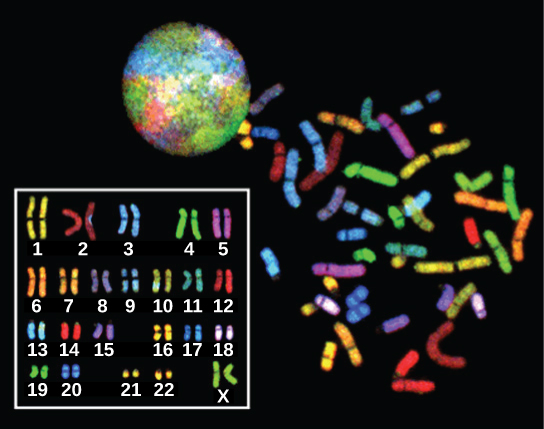
Each copy of the homologous pair of chromosomes originates from a different parent; therefore, the copies of each of the genes themselves may not be identical. The variation of individuals within a species is caused by the specific combination of the genes inherited from both parents. For example, there are three possible gene sequences on the human chromosome that codes for blood type: sequence A, sequence B, and sequence O. Because all diploid human cells have two copies of the chromosome that determines blood type, the blood type (the trait) is determined by which two versions of the marker gene are inherited. It is possible to have two copies of the same gene sequence, one on each homologous chromosome (for example, AA, BB, or OO), or two different sequences, such as AB. This is due to incomplete dominance or codominance. Subsequent chapters will discuss these concepts of patterns of inheritance.
Minor variations in traits such as those for blood type, eye color, and height contribute to the natural variation found within a species. However, if the entire DNA sequence from any pair of human homologous chromosomes is compared, the difference is much less than one percent. The sex chromosomes, X and Y, are the single exception to the rule of homologous chromosomes; other than a small amount of homology that is necessary to reliably produce gametes, the genes found on the X and Y chromosomes are not the same.
The continuity of life from one cell to another has its foundation in the reproduction of cells by way of the cell cycle. The cell cycle is an orderly sequence of events in the life of a cell, from the division of a single parent cell to produce two new daughter cells to the subsequent division of those daughter cells. The mechanisms involved in the cell cycle are highly conserved across eukaryotes.
The Cell Cycle
The cell cycle is an ordered series of events involving cell growth and cell division that produces two new daughter cells. Cells on the path to cell division proceed through a series of precisely timed and carefully regulated stages of growth, DNA replication, and division that produce two genetically identical cells. The cell cycle has two major phases: interphase and the mitotic phase (Figure 2.24). During interphase, the cell grows and DNA is replicated. During the mitotic phase, the replicated DNA and cytoplasmic contents are separated and the cell divides.
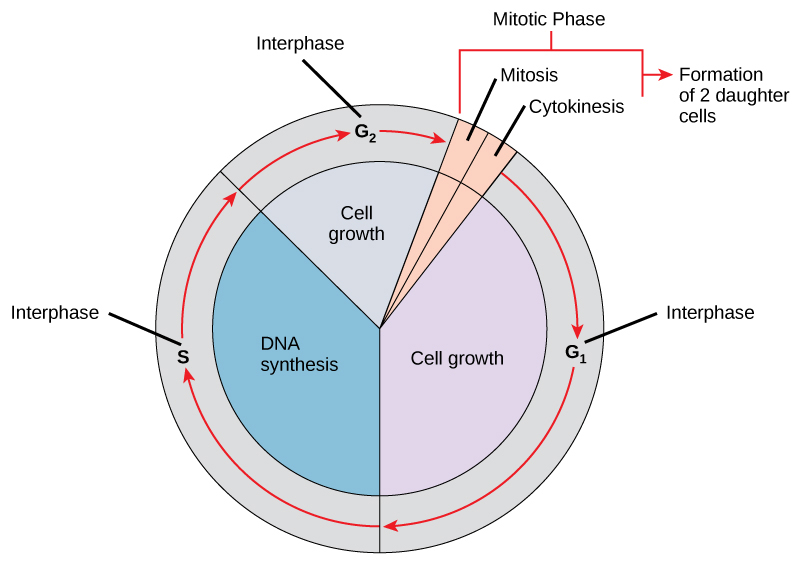
Interphase
During interphase, the cell undergoes normal processes while also preparing for cell division. For a cell to move from interphase to the mitotic phase, many internal and external conditions must be met. The three stages of interphase are called G1, S, and G2.
G1 Phase
The first stage of interphase is called the G1 phase, or first gap, because little change is visible. However, during the G1 stage, the cell is quite active at the biochemical level. The cell is accumulating the building blocks of chromosomal DNA and the associated proteins, as well as accumulating enough energy reserves to complete the task of replicating each chromosome in the nucleus.
S Phase
Throughout interphase, nuclear DNA remains in a semi-condensed chromatin configuration. In the S phase (synthesis phase), DNA replication results in the formation of two identical copies of each chromosome—sister chromatids—that are firmly attached at the centromere region. At this stage, each chromosome is made of two sister chromatids and is a duplicated chromosome. The centrosome is duplicated during the S phase. The two centrosomes will give rise to the mitotic spindle, the apparatus that orchestrates the movement of chromosomes during mitosis. The centrosome consists of a pair of rod-like centrioles at right angles to each other. Centrioles help organize cell division. Centrioles are not present in the centrosomes of many eukaryotic species, such as plants and most fungi.
G2 Phase
In the G2 phase, or second gap, the cell replenishes its energy stores and synthesizes the proteins necessary for chromosome manipulation. Some cell organelles are duplicated, and the cytoskeleton is dismantled to provide resources for the mitotic spindle. There may be additional cell growth during G2. The final preparations for the mitotic phase must be completed before the cell is able to enter the first stage of mitosis.
The Mitotic Phase
To make two daughter cells, the contents of the nucleus and the cytoplasm must be divided. The mitotic phase is a multistep process during which the duplicated chromosomes are aligned, separated, and moved to opposite poles of the cell, and then the cell is divided into two new identical daughter cells. The first portion of the mitotic phase, mitosis, is composed of five stages, which accomplish nuclear division. The second portion of the mitotic phase, called cytokinesis, is the physical separation of the cytoplasmic components into two daughter cells.
Mitosis
Mitosis is divided into a series of phases— prophase, prometaphase, metaphase, anaphase, and telophase—that result in the division of the cell nucleus (Figure 2.25).
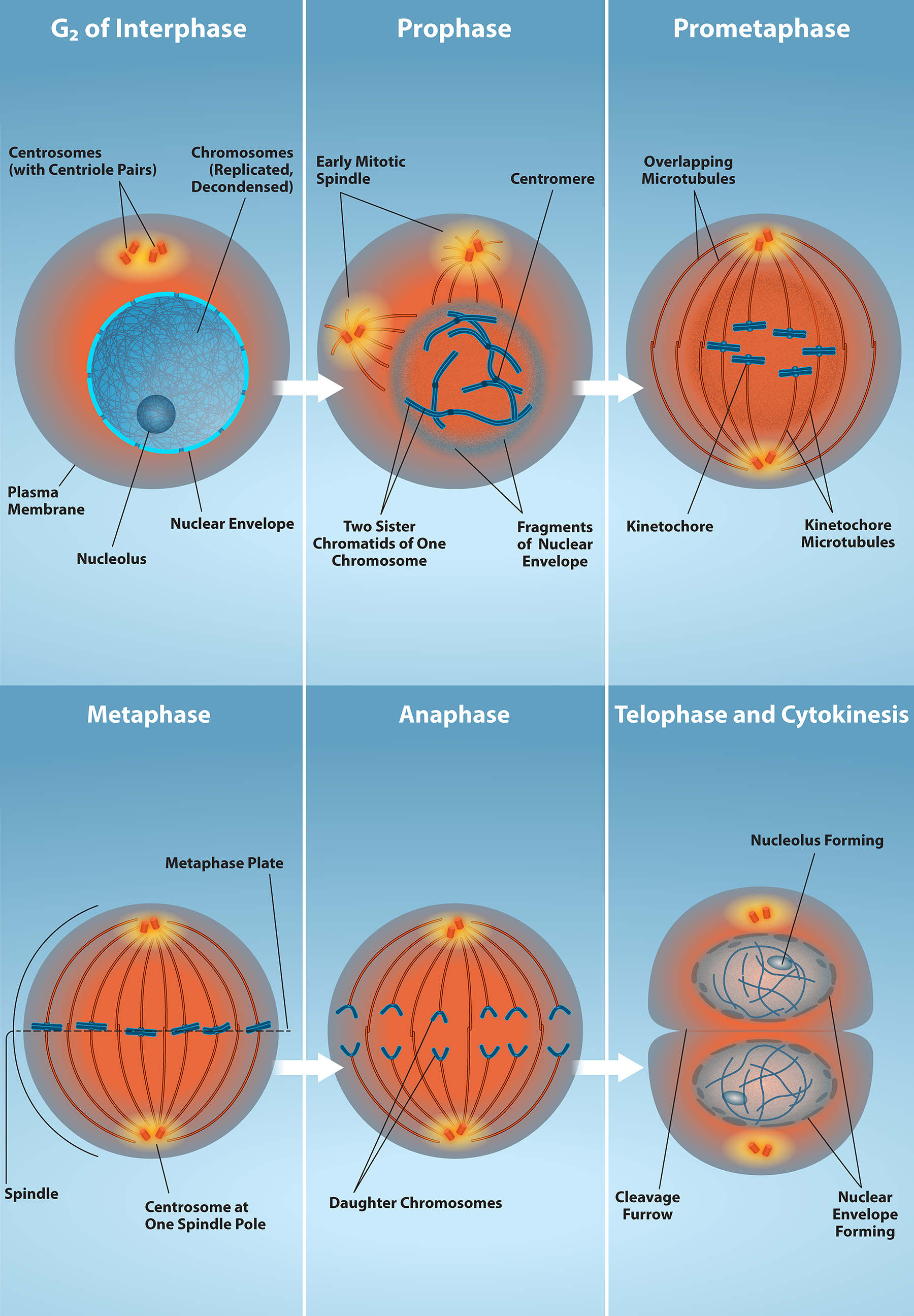
During prophase, the “first phase,” several events must occur to provide access to the chromosomes in the nucleus. The nuclear envelope starts to break into small vesicles, and the Golgi apparatus and endoplasmic reticulum fragment and disperse to the periphery of the cell. The nucleolus disappears. The centrosomes begin to move to opposite poles of the cell. The microtubules that form the basis of the mitotic spindle extend between the centrosomes, pushing them farther apart as the microtubule fibers lengthen. The sister chromatids begin to coil more tightly and become visible under a light microscope.
During prometaphase, many processes that were begun in prophase continue to advance and culminate in the formation of a connection between the chromosomes and cytoskeleton. The remnants of the nuclear envelope disappear. The mitotic spindle continues to develop as more microtubules assemble and stretch across the length of the former nuclear area. Chromosomes become more condensed and visually discrete. Each sister chromatid attaches to spindle microtubules at the centromere via a protein complex called the kinetochore.
During metaphase, all of the chromosomes are aligned in a plane called the metaphase plate, or the equatorial plane, midway between the two poles of the cell. The sister chromatids are still tightly attached to each other. At this time, the chromosomes are maximally condensed.
During anaphase, the sister chromatids at the equatorial plane are split apart at the centromere. Each chromatid, now called a chromosome, is pulled rapidly toward the centrosome to which its microtubule was attached. The cell becomes visibly elongated as the non-kinetochore microtubules slide against each other at the metaphase plate where they overlap.
During telophase, all of the events that set up the duplicated chromosomes for mitosis during the first three phases are reversed. The chromosomes reach the opposite poles and begin to decondense (unravel). The mitotic spindles are broken down into monomers that will be used to assemble cytoskeleton components for each daughter cell. Nuclear envelopes form around chromosomes.
Concept in Action – Mitosis
Watch Mitosis: The Amazing Cell Process that Uses Division to Multiply! (Updated) (6 mins) on YouTube
Video source: Amoeba Sisters. (2015, September 15). Chromosome numbers during division: Demystified! [Video]. YouTube. https://www.youtube.com/watch?v=gcz1FOWw0Cg
Cytokinesis
Cytokinesis is the second part of the mitotic phase during which cell division is completed by the physical separation of the cytoplasmic components into two daughter cells. Although the stages of mitosis are similar for most eukaryotes, the process of cytokinesis is quite different for eukaryotes that have cell walls, such as plant cells.
In cells such as animal cells that lack cell walls, cytokinesis begins following the onset of anaphase. A contractile ring composed of actin filaments forms just inside the plasma membrane at the former metaphase plate. The actin filaments pull the equator of the cell inward, forming a fissure. This fissure, or “crack,” is called the cleavage furrow. The furrow deepens as the actin ring contracts, and eventually the membrane and cell are cleaved in two (Figure 2.25).
In plant cells, a cleavage furrow is not possible because of the rigid cell walls surrounding the plasma membrane. A new cell wall must form between the daughter cells. During interphase, the Golgi apparatus accumulates enzymes, structural proteins, and glucose molecules prior to breaking up into vesicles and dispersing throughout the dividing cell. During telophase, these Golgi vesicles move on microtubules to collect at the metaphase plate. There, the vesicles fuse from the center toward the cell walls; this structure is called a cell plate. As more vesicles fuse, the cell plate enlarges until it merges with the cell wall at the periphery of the cell. Enzymes use the glucose that has accumulated between the membrane layers to build a new cell wall of cellulose. The Golgi membranes become the plasma membrane on either side of the new cell wall (Figure 2.26).
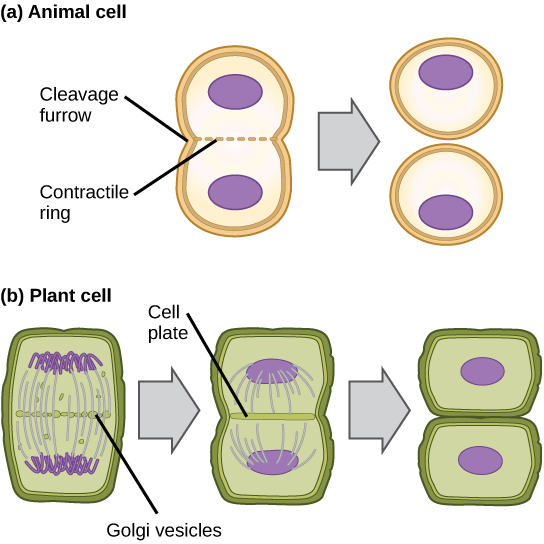
Concept in Action – Cell Cycle
G0 Phase
Not all cells adhere to the classic cell-cycle pattern in which a newly formed daughter cell immediately enters interphase, closely followed by the mitotic phase. Cells in the G0 phase are not actively preparing to divide. The cell is in a quiescent (inactive) stage, having exited the cell cycle. Some cells enter G0 temporarily until an external signal triggers the onset of G1. Other cells that never or rarely divide, such as mature cardiac muscle and nerve cells, remain in G0 permanently (Figure 2.27).
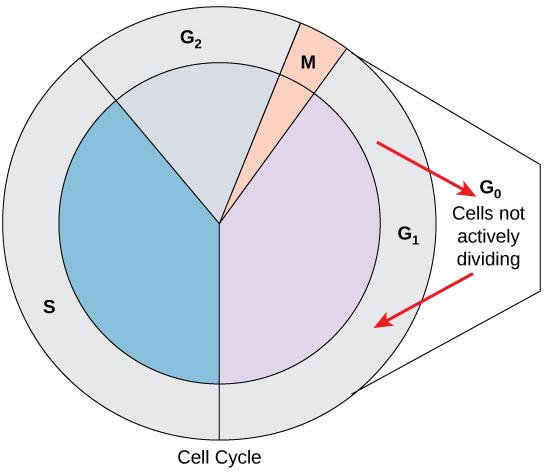
Control of the Cell Cycle
The length of the cell cycle is highly variable even within the cells of an individual organism. In humans, the frequency of cell turnover ranges from a few hours in early embryonic development to an average of two to five days for epithelial cells, or to an entire human lifetime spent in G0 by specialized cells such as cortical neurons or cardiac muscle cells. There is also variation in the time that a cell spends in each phase of the cell cycle. When fast-dividing mammalian cells are grown in culture (outside the body under optimal growing conditions), the length of the cycle is approximately 24 hours. In rapidly dividing human cells with a 24-hour cell cycle, the G1 phase lasts approximately 11 hours. The timing of events in the cell cycle is controlled by mechanisms that are both internal and external to the cell.
Regulation at Internal Checkpoints
It is essential that daughter cells be exact duplicates of the parent cell. Mistakes in the duplication or distribution of the chromosomes lead to gene variants (mutations) that may be passed forward to every new cell produced from the abnormal cell. To prevent a compromised cell from continuing to divide, there are internal control mechanisms that operate at three main cell cycle checkpoints at which the cell cycle can be stopped until conditions are favorable. These checkpoints occur near the end of G1, at the G2–M transition, and during metaphase (Figure 2.28).
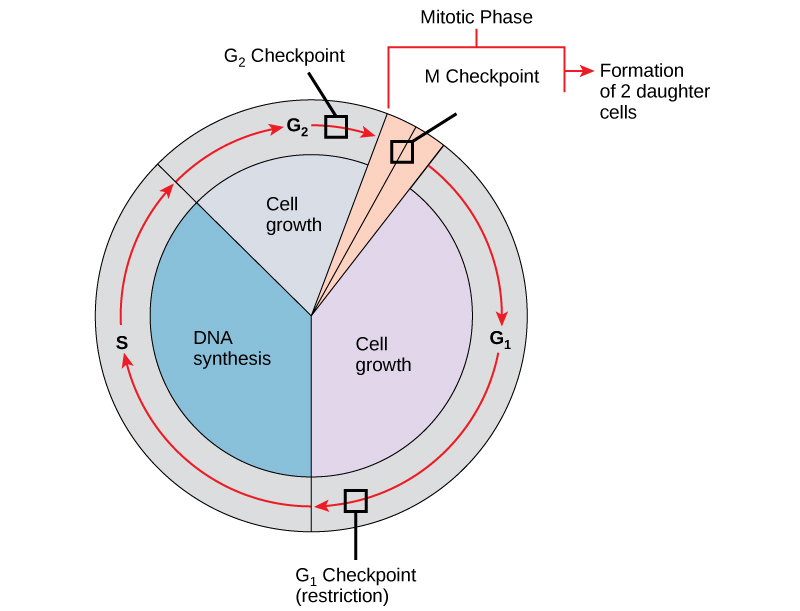
The G1 Checkpoint
The G1 checkpoint determines whether all conditions are favorable for cell division to proceed. The G1 checkpoint, also called the restriction point, is the point at which the cell irreversibly commits to the cell-division process. In addition to adequate reserves and cell size, there is a check for damage to the genomic DNA at the G1 checkpoint. A cell that does not meet all the requirements will not be released into the S phase.
The G2 Checkpoint
The G2 checkpoint bars the entry to the mitotic phase if certain conditions are not met. As in the G1 checkpoint, cell size and protein reserves are assessed. However, the most important role of the G2 checkpoint is to ensure that all of the chromosomes have been replicated and that the replicated DNA is not damaged.
The M Checkpoint
The M checkpoint occurs near the end of the metaphase stage of mitosis. The M checkpoint is also known as the spindle checkpoint because it determines if all the sister chromatids are correctly attached to the spindle microtubules. Because the separation of the sister chromatids during anaphase is an irreversible step, the cycle will not proceed until the kinetochores of each pair of sister chromatids are firmly anchored to spindle fibers arising from opposite poles of the cell.
Concept in Action – Eukaryotic Cell Cycle
Check out this interactive content that explains these concepts by visiting The Eukaryotic Cell Cycle and Cancer.
Exercises
Exercises (text version)
- True or false? The longest phase in the cell cycle is the M or Mitosis phase.
- Fill in the blanks to complete the statement:
Matched pairs of chromosomes are called [Blank A] chromosomes. These chromosomes have the same [Blank B] at the same locations. They may have differing [Blank C] , which are differing versions of the same gene.
The number of chromosomes Humans have is [Blank D].
The term [Blank E] or 2n applies to body cells that have matched pairs of chromosomes. Gametes like sperm and eggs are called [Blank F] or n as they have only one copy of each chromosome.
The process called [Blank G] results in the creation of identical cells. In bacterial (prokaryotic cells) the process of making identical cells is called [Blank H].
The process of [Blank i] occurs in S-phase of interphase.
In the [Blank J] stage of mitosis chromosomes become visible when viewed down the microscope. - How many chromosomes does a diploid cell have compared a haploid cell?
- one-fourth
- one-half
- twice
- four times
- What specific combination is inherited that determines an organism’s traits?
- cells
- genes
- proteins
- chromatids
- Match the words into the correct blanks to compare the characteristics of a human somatic cell to a human gamete.
Words: haploid/n, one, forty-six, twenty-three, n/haploid, 2n/diploid, non-homologous, homologous, twenty-two, diploid/2n
Human somatic cells have [Blank A] chromosomes, including [Blank B] [Blank C] pairs and [Blank D] pair of [Blank E] sex chromosomes. This is the [Blank F], or [Blank G], condition. Human gametes have one each of [Blank H] unique chromosomes. This is the [Blank i], or [Blank J] condition. - Which of the following statements describes the correct order of events in mitosis?
- Sister chromatids line up at the metaphase plate. The kinetochore becomes attached to the mitotic spindle. The nucleus re-forms and the cell divides. The sister chromatids separate.
- The kinetochore becomes attached to the mitotic spindle. The sister chromatids separate. Sister chromatids line up at the metaphase plate. The nucleus re-forms and the cell divides.
- The kinetochore becomes attached to metaphase plate. Sister chromatids line up at the metaphase plate. The kinetochore breaks down and the sister chromatids separate. The nucleus re-forms and the cell divides.
- The kinetochore becomes attached to the mitotic spindle. Sister chromatids line up at the metaphase plate. The kinetochore breaks apart and the sister chromatids separate. The nucleus re-forms and the cell divides.
- In what portion of the cell cycle are chromosomes duplicated?
- G1 phase
- S phase
- prophase
- prometaphase
- In what stage of mitosis is the separation of the sister chromatids characteristic?
- prometaphase
- metaphase
- anaphase
- telophase
- In what stage of mitosis do the individual chromosomes become visible with a light microscope?
- prophase
- prometaphase
- metaphase
- anaphase
- What condition is necessary for a cell to pass the G2 checkpoint?
- cell has reached a sufficient size
- an adequate stockpile of nucleotides
- accurate and complete DNA replication
- proper attachment of mitotic spindle fibers to kinetochores
Check your answers in footnote[1]
Activity source: Exercises by Andrea Gretchev is licensed under CC BY-NC 4.0, except where otherwise noted. Rearranged from Concepts of Biology – 1st Canadian Edition
Attribution & References
Except where otherwise noted, this page is adapted from
-
- 6.1 The Genome and 6.2 The Cell Cycle In Concepts of Biology – 1st Canadian Edition by by Charles Molnar and Jane Gair, CC BY 4.0. / A derivative of Concepts of Biology (OpenStax), CC BY 4.0. Access Biology 2e for free at OpenStax
Individual sections have been combined and streamlined, including minor edits to improve student understanding and provide context.
-
- False.
- A - homologous, B - genes, C - alleles, D - 46, E -diploid, F - haploid - G - mitosis, H - binary fission, i - replication/DNA replication, J - prophase
- c) twice
- b) genes
- A - forty-six, B - twenty-two, C - homologous, D - one, E - non-homologous, F - 2n/diploid, G - diploid/2n, H - twenty-three, i - n/haploid, J - haploid/n
- d) The kinetochore becomes attached to the mitotic spindle. Sister chromatids line up at the metaphase plate. The kinetochore breaks apart and the sister chromatids separate. The nucleus re-forms and the cell divides.
- b) S phase
- c) anaphase
- a) prophase
- c) accurate and complete DNA replication
the ordered sequence of events that a cell passes through between one cell division and the next
the period of the cell cycle leading up to mitosis; includes G1, S, and G2 phases; the interim between two consecutive cell divisions
the period of the cell cycle when duplicated chromosomes are distributed into two nuclei and the cytoplasmic contents are divided; includes mitosis and cytokinesis
(also, first gap) a cell-cycle phase; first phase of interphase centered on cell growth during mitosis
the second, or synthesis phase, of interphase during which DNA replication occurs
the microtubule apparatus that orchestrates the movement of chromosomes during mitosis
a paired rod-like structure constructed of microtubules at the center of each animal cell centrosome
(also, second gap) a cell-cycle phase; third phase of interphase where the cell undergoes the final preparations for mitosis
the division of the cytoplasm following mitosis to form two daughter cells
the stage of mitosis during which chromosomes condense and the mitotic spindle begins to form
the stage of mitosis during which mitotic spindle fibers attach to kinetochores
the stage of mitosis during which chromosomes are lined up at the metaphase plate
the equatorial plane midway between two poles of a cell where the chromosomes align during metaphase
the stage of mitosis during which sister chromatids are separated from each other
the stage of mitosis during which chromosomes arrive at opposite poles, decondense, and are surrounded by new nuclear envelopes
a constriction formed by the actin ring during animal-cell cytokinesis that leads to cytoplasmic division
a cell-cycle phase distinct from the G1 phase of interphase; a cell in G0 is not preparing to divide
describes a cell that is performing normal cell functions and has not initiated preparations for cell division
cell cycle checkpoints

